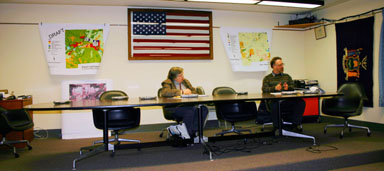February 20, 2004
Not quite a Planning Board meeting on Varna, Etna
Last night's meeting for "discussing revisions to the Draft Comprehensive Plan" wasn't precisely a Planning Board meeting, as only two members of the board were there (four are necessary for action), and only six people were in the audience, including County Legislator Martha Robertson. George Frantz, the planner consulting on the work, and Debbie Gross, the Town of Dryden's Environmental Planner, were also there.

Planning Board members at Thursday night's meeting.
There was also a question about minutes, as the recording secretary wasn't present, and the Planning Board minutes haven't been published since 2001. The meeting was recorded, however. After some brief questions about whether to proceed with discussion, the conversation began as a "subcommittee meeting".
Most of the questions were about the details of the planning for hamlets in the Draft Comprehensive Plan. Figure 5-1, the Future Land Use Plan (301KB PDF), shows hamlet areas in yellow and doesn't make any distinctions inside of that yellow. That yellow refers to an area where "the residential development density proposed for the hamlet areas is an average of 8 dwellings per acre", a significant-feeling jump in density, perhaps even more in Etna than in Varna.
A lot of the discussion revolved around managing such a jump. David Weinstein had earlier proposed changing that to "a maximum of 4 dwellings per acre", which is a rather different thing. As Debbie Gross pointed out, it's not just the difference between 4 and 8, but the use of "average" versus "maximum". I've suggested that the existing language "seems like an invitation to turn Varna into a collection of apartment complexes and duplexes like the 'Lucenteland' zone".
There were a lot of options, which aren't currently in the plan, for controlling such development. Many of them revolve around how the plan is implemented iin zoning. Rather than simply allowing dense development in the hamlets, the zoning could either require a special permit for such building - which is not hard to get - or use zoning that is less dense and require developers to request rezoning if they want to build dense developers. The special permit approach places the burden on the town to say why a given development is not appropriate, while requiring rezoning places the burden on developers to explain why a development would be appropriate. The latter approach gives the town far more control over its own destiny.
Managing the balance of rental and owner-occupied property was another large question. The plan already notes on page 40 that "in Varna the lack of maintenance of rental properties owned by absentee landlords is resulting in the appearance of blight," and Etna residents didn't want that blight spreading to their hamlet. Again, it seems that there are things that can be done through zoning, and which could be recommended by the Plan, which aren't there at present.
Mixing commercial with residential uses was another key question for the hamlets, as growing the hamlets into more village-like places is a lot of why higher density in being proposed. Dropping a McDonald's into Etna or Varna might provide a restaurant, for instance, but it would also drastically change the place, likely attracting new traffic that wouldn't necessarily have been there anyway. George Frantz had suggestions for controlling the kinds of business in a given area with maximum setbacks from the road and bans on drive-throughs, reducing the impact of massive parking lots out front and cars passing through.
Architectural design issues also came up, in large part because recent developments don't really look like anything that was in the hamlets before, making the distinctions between new and old more jarring. Frantz suggested that style requirements for new construction was a possibility for minimizing these problems. Such requirements wouldn't apply to single-family homes (unless perhaps a hamlet became a historic district, which seems unlikely), but they could preserve the overall look of the hamlets.
Frantz noted that he'd spoken with Varna Community Association board chair Mike Richardson about the possibility of having Cornell students work on a charrette, inviting community members' input for producing detailed architectural drawings of possible looks for the hamlets.
Late in the meeting, there was some discussion of the Etna Etna Industry / Office / Research Area along Route 13 and Etna Lane, with general consensus that it might better be reduced to include only the current Aramark facility, itself a recipient of a special permit. Other areas in the Route 13/366 overlap are already zoned for industrial use, and have far fewer residents. At the same time, the plan may try to keep a barrier of green along Route 13 that separates the "Ithaca" area from the "Dryden" area.
For something officially not a meeting, there was a tremendous amount of conversation, extending beyond the Planning Board's normal 9pm meeting conclusion. Hopefully the next few meetings will have the same level of conversation but better attendance.
Posted by simonstl at February 20, 2004 03:23 PMNote on photos